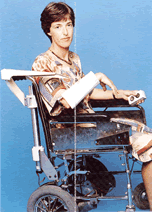| enginuity |
|
Design expansion
The Engineering Design Centre (EDC), set up in 1991, and funded by the EPSRC, provides an interface between research and industry. By linking their basic design research to a number of specific applications, often presented to them as design problems by industrial companies, they aim to develop generic design methods. At the moment, the research team of around 30 design theorists, computer scientists and experienced design engineers, apply the methods resulting from their design research in three main areas: aerospace systems, heavy-duty vehicles (see enginuity 2) , and medical and rehabilitation equipment. An exciting new area in which the team is becoming increasingly involved is micro-mechanisms, in keeping with the worldwide drive for miniaturisation.
Design developments
An example of how the Centre works is provided by a project being undertaken in collaboration with Caterpillar. By analysing the reliability of systems in a backhoe loader, a prototype method for identifying potential reliability problem areas at the design stage is being developed. As this method can equally well be applied during the design of other products, this is typical of how looking at specific applications can lead to the development of generic design methods of use to industry as a whole.

Prototype mobile arm support for muscular dystrophy sufferers.
To demonstrate the integration of all the methods and tools being developed in the EDC, a novel mobile arm support has been designed and a prototype manufactured. The development of the Cambridge Materials Selector (see enginuity 2) also demonstrates how research within the EDC can be transformed into a design tool readily usable by industry.
Further information from the EDC's Director, Ken Wallace, on: (01223) 332742.
| number 3, summer '94 |